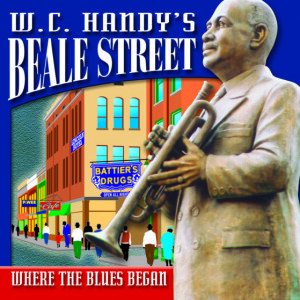 The year 2003 was named “Year of the Blues” in the U.S. because it was in 1903 that an African-American musician named William Christopher Handy first heard the music that later came to be known as the blues. In a tale that has risen nearly to the mythical level of Robert Johnson’s crossroads experience, Handy heard a man on a train singing a three-line repeated phrase while playing his guitar using a knife-blade as a slide.
The year 2003 was named “Year of the Blues” in the U.S. because it was in 1903 that an African-American musician named William Christopher Handy first heard the music that later came to be known as the blues. In a tale that has risen nearly to the mythical level of Robert Johnson’s crossroads experience, Handy heard a man on a train singing a three-line repeated phrase while playing his guitar using a knife-blade as a slide.
It took a few years for him to capitalize on this experience, but eventually Handy became the first major composer of blues music, with its ragtime-influenced syncopation and its flatted notes and its repetitive verse structure. The best known, of course, is the “St. Louis Blues,” which became a hit in each of the next three decades, and is still instantly recognizable today.
Handy wrote most of his compositions for a small dance orchestra, though he also wrote words for most of them.
Carl Wolfe and his Memphis Jazz Orchestra on this disc present 21 of Handy’s seminal compositions, as they might have been heard in their original form. The ensemble includes trumpet, trombone, clarinet, saxophone (Handy was the first to use the instrument in an orchestral setting), violin, banjo, piano and tuba. W.C. Handy’s Beale Street, subtitled “Where the Blues Began,” is a charming recording; historically important, but also great fun to listen to.
It has compositions ranging from some of Handy’s earliest (“Memphis Blues,” 1909), to latest, (“Chantez Les Bas,” 1931). The earliest works I would term blues rags, having much affinity with the works of pioneers like Scott Joplin; while the later works, particularly “Chantez Les Bas (Sing it Low)” are clearly proto-swing. Most of the early works, from “Memphis Blues” on, have a pronounced boogie-woogie beat — think of the syncopated beat later used by Glenn Miller in “In the Mood.”
Highlights include those two tracks, as well as “St. Louis Blues,” which has some hot clarinet licks; “Aunt Hagar’s Children Blues,” a gospel-tinged slow foxtrot that starts off with the trumpet solo on the melody line, backed by just tuba and banjo; “Friendless Blues,” which has a bass line instantly recognizable as one later used in dozens of Western-movie themes; “Atlanta Blues,” which incorporates the well-known “make me a pallet on your floor” melody in the second half; “Joe Turner Blues,” a classic 12-bar with violin in lead or in duet with clarinet on the melody line; “Hesitating Blues,” which is still being played and recorded today, and whose melody was worked into Handy’s “Yellow Dog Blues,” also on this disc; and the swinging, jazzy and swaggering “Wall Street Blues.”
The band is top notch, and the recording is clear and immediate. I believe all the tracks were recorded live in the studio. If not, they achieve that feel of spontaniety. The liner notes are succinct but informative.
Listening to all 21 of these tracks at once may be a bit much, unless you’re a rabid fan of early jazz. Unless you’re careful, they all start sounding alike after a while. But this is a fine recording, well played and enjoyable to listen to. The blues should always be so much fun.
(Inside Sounds, 2002)
